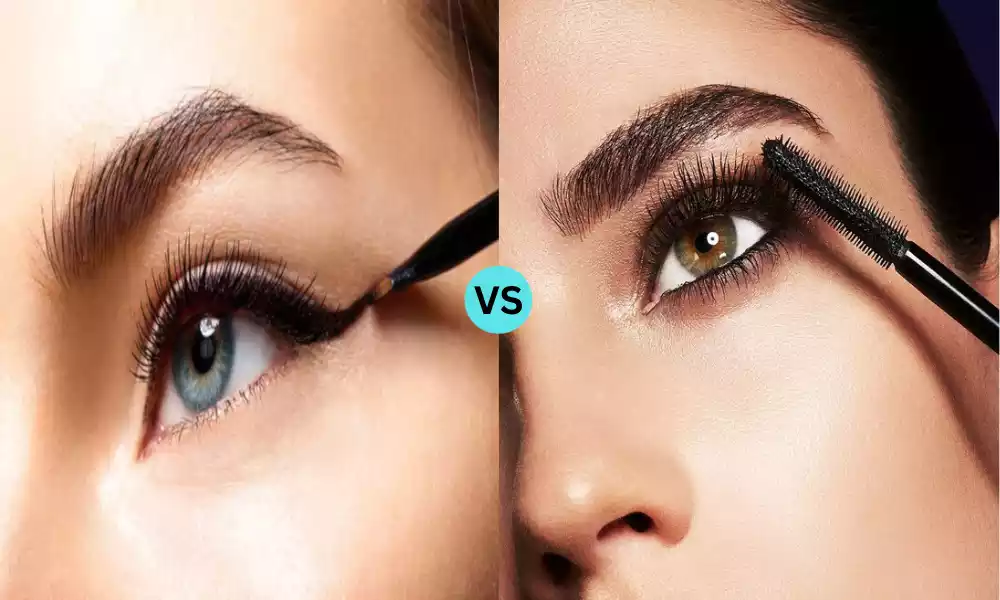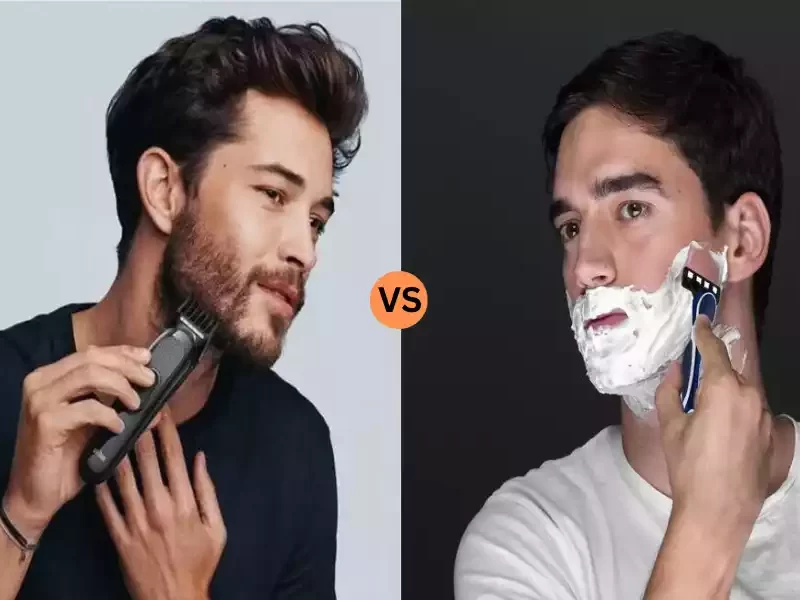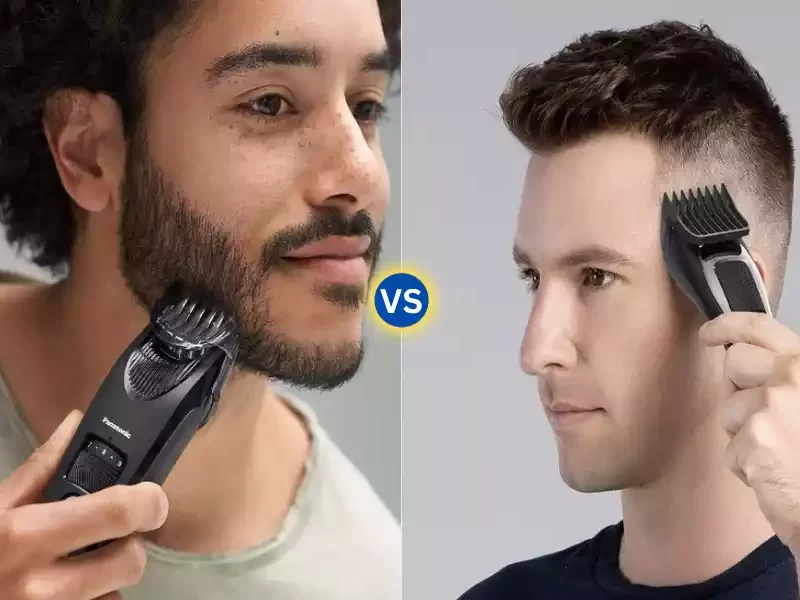Eyeliner and Mascara are two cornerstone products in the world of eye makeup, each serving distinct yet complementary roles in accentuating and defining the eyes. Eyeliner, with its rich historical roots tracing back to ancient civilizations, is designed to delineate the eyes by drawing lines around their contours, thus enhancing their shape and adding depth.
Mascara, on the other hand, targets the eyelashes, darkening, lengthening, and often volumizing them to make the eyes appear more awake and captivating. Together, these cosmetics offer a dynamic duo that can transform and elevate any look, from the subtlest natural enhancement to the most dramatic statement.
What is an Eyeliner?
An eyeliner is a cosmetic product used to define and accentuate the eyes by drawing lines around their contours, typically along the upper and lower lash lines. Its purpose is to enhance the shape of the eyes, make them appear larger or more elongated, and complement or contrast with the natural eye color. Eyeliners come in various forms, including pencil, gel, liquid, and powder, and are available in a multitude of colors and finishes, from matte to shimmer. They can be used to create various looks, from subtle and natural to bold and dramatic.
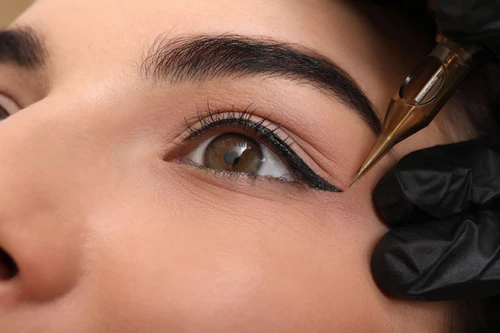
What is Mascara?
Mascara is a cosmetic product designed to enhance the eyelashes by darkening, lengthening, thickening, and/or curling them. Applied using a brush or wand, mascara emphasizes the eyes, making them stand out and appear more vibrant and awake. It comes in different formulas, with waterproof and non-waterproof versions being the most common. Additionally, various brush designs are available to achieve specific effects on the lashes, such as volumizing, lengthening, or separating. Mascara is a staple in many makeup routines, providing the finishing touch to accentuate the eyes.
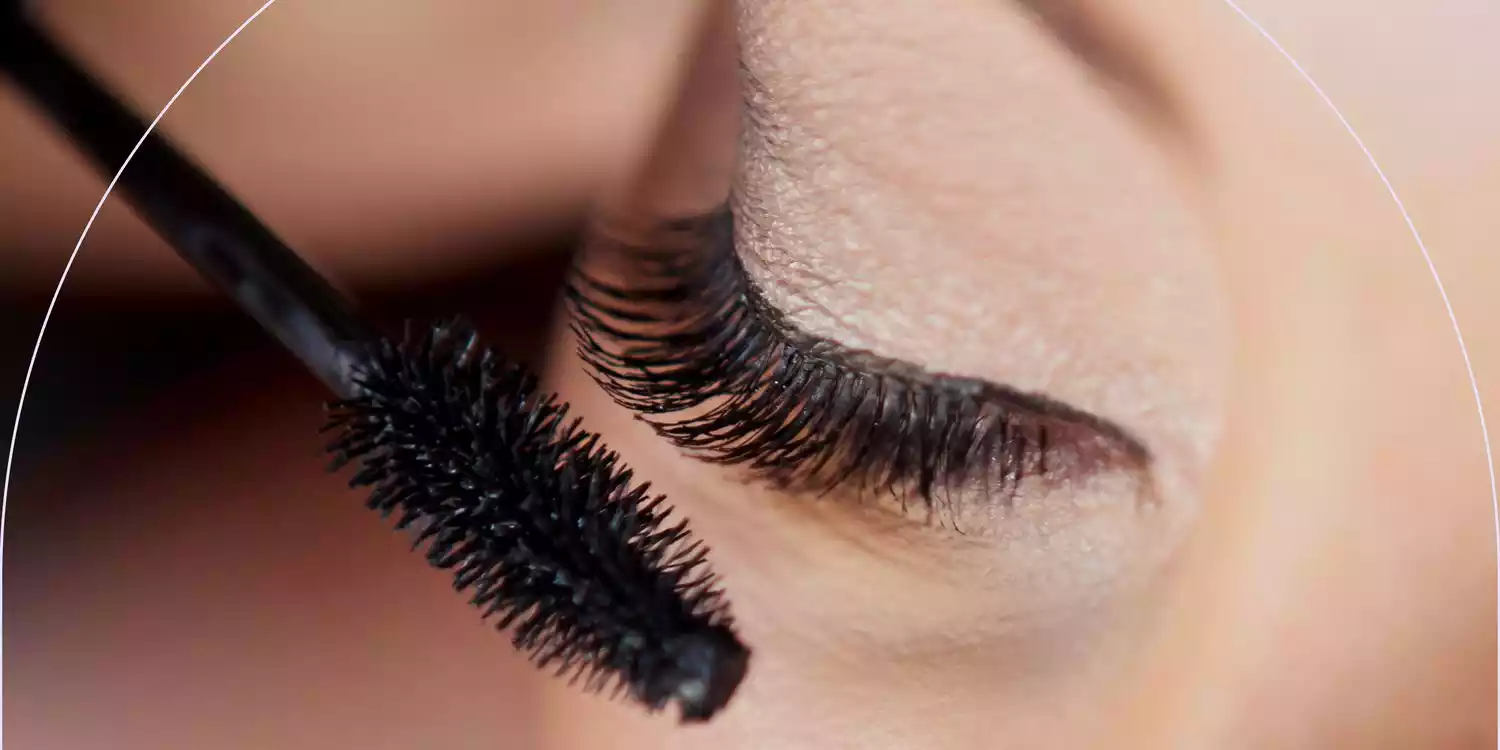
Types and Variations
Both eyeliner and mascara have evolved over the years, resulting in various types and variations to suit different styles, preferences, and occasions. Here’s a breakdown:
Eyeliner
- Pencil Eyeliner:
- Standard Pencil: Requires sharpening.
- Retractable or Twist-Up: No sharpening needed.
- Kohl: Soft, smudgy, and often used for smoky looks.
- Liquid Eyeliner:
- Felt-tip or Marker: Pen-like with a precise tip.
- Brush Applicator: Offers versatility in line thickness.
- Dip Brush: Comes in a separate bottle, needs to be dipped.
- Gel or Cream Eyeliner:
- Pot: Typically comes in a small pot and is applied with a brush.
- Pen or Twist-Up: More portable and less messy than traditional pots.
- Powder Eyeliner:
- Applied using an angled brush and can also be used for a softer, smoky look.
- Felt-tip Pen:
- Marker-like pens that are precise and often preferred for winged looks.
- Waterproof Varieties:
- Available in most types, ensuring longevity and resistance to smudging.
Mascara
- Volumizing Mascara:
- Designed to make lashes look denser and fuller.
- Lengthening Mascara:
- Contains nylon or rayon fibers to extend the tips of the lashes.
- Curling Mascara:
- Curved wand design and specific formula to give lashes an upward curl.
- Waterproof Mascara:
- Resistant to water, sweat, and tears.
- Tubing Mascara:
- Wraps lashes in polymer tubes, providing length and staying power. Comes off with warm water in tubes.
- Fiber Mascara:
- Contains tiny fibers (usually made of silk, rayon, or nylon) that adhere to your lashes to extend and add volume.
- Clear or Transparent Mascara:
- Can be used to enhance lashes subtly or to groom eyebrows.
- Primer or Base Mascara:
- Usually white, applied before colored mascara to amplify its effects.
- Lash Tint:
- A more permanent option that dyes lashes for weeks.
For both eyeliners and mascaras, innovations and variations continue to emerge in the beauty industry. Many brands also focus on vegan, cruelty-free, and hypoallergenic options to cater to a wider range of consumers. Always select products based on personal preferences, the look you’re aiming for, and any skin or eye sensitivities you may have.
Ingredients and Composition of Eyeliner and Mascara
Both eyeliner and mascara are formulated to adhere well to the skin and lashes, respectively, and to last throughout the day. The ingredients and composition can vary between products and brands, depending on the desired finish, wear-time, and other properties. Here’s a general overview of ingredients commonly found in eyeliners and mascaras:
Eyeliner:
- Wax: Used to give structure to pencil eyeliners. Common waxes include paraffin, beeswax, and carnauba wax.
- Oils: Used in pencil and gel eyeliners to provide a smooth application. Examples include castor oil and lanolin.
- Pigments: Provide the color. Carbon black and iron oxides are common pigments used for black and brown eyeliners.
- Thickeners: Used in gel and liquid eyeliners to provide body to the product. Examples include clay and silica.
- Polymers: Present in liquid eyeliners to form a film when the product dries, ensuring long wear.
- Preservatives: To extend the shelf life of the product and prevent bacterial growth. Common ones include parabens (though many brands now use paraben-free preservatives due to consumer demand).
- Emollients: For a smooth application, especially in gel liners.
- Stabilizers: To prevent ingredients from separating.
- Solvents: Used in liquid eyeliners to dissolve other ingredients and can be water or alcohol-based.
Mascara:
- Wax: Provides structure and volume. Commonly used waxes are paraffin, beeswax, and carnauba wax.
- Oils: Help with the smooth application of the product. Oils such as mineral oil, lanolin, and sesame oil can be found in mascaras.
- Pigments: Carbon black and iron oxides are used for black and brown mascaras, respectively.
- Polymers: To help the mascara form a film on lashes and provide lengthening or volumizing effects.
- Preservatives: Such as parabens (though many brands are shifting to paraben-free alternatives).
- Thickeners: Ingredients like clay or silica to add volume to lashes.
- Emulsifying Agents: Help to mix the water and oil components of mascara.
- Fibers: Found in fiber mascaras to lengthen and add volume to the lashes. Examples include rayon or nylon fibers.
- Proteins: Such as keratin, to strengthen and condition the lashes.
- Solvents: Water is a primary solvent in many mascaras, especially non-waterproof ones.
Specific formulas and ingredients can vary widely between brands and specific product lines. If someone has sensitive skin or eyes, or if they’re concerned about potential allergic reactions, it’s a good idea to carefully check the ingredient list before purchasing or applying a product.
The importance of eyeliner and mascara in enhancing the eyes
Eyeliner and mascara play pivotal roles in the realm of makeup and aesthetics, specifically in accentuating one of our most expressive features the eyes. Here’s a breakdown of their importance:
- Defining the Eyes: Much like a frame enhances a painting, eyeliner provides a contour that emphasizes the shape of the eyes. By creating contrast, it makes the eyes stand out and appear more defined against the rest of the facial features.
- Creating Illusions: Eyeliners can be used to modify the perceived shape and size of the eyes. A winged liner can make the eyes look elongated, while liner on the lower lid can create the illusion of bigger eyes. Mascara, on the other hand, makes lashes appear longer and fuller, giving the eyes a wider, more open look.
- Enhancing Lash Volume and Length: Mascara is specially formulated to coat each lash, adding both volume and length. This not only intensifies the gaze but also adds a touch of drama, especially with volumizing or lengthening mascaras.
- Depth and Intensity: Dark eyeliner and mascara add depth to the eyes, making them appear more profound and intense. This is especially noticeable in individuals with light-colored lashes or less defined eye contours.
- Complementing Eye Color: The variety of eyeliner shades available allows one to choose colors that complement or contrast their natural eye color, making the iris stand out more. For instance, brown eyeliner can enhance the warmth of hazel eyes, while blue or green liners can intensify blue or green eyes.
- Completing a Look: In the context of a full face of makeup, eyeliner and mascara play a crucial role in tying together various elements. Whether it’s a smoky eye, a classic wing, or a natural look, these products provide the finishing touches that bring coherence to the overall makeup design.
- Expressing Individuality: Beyond the aesthetics, makeup is a form of self-expression. The style in which one applies eyeliner or the type of mascara chosen can reflect personal style, mood, or even cultural influences.
- Boosting Confidence: For many, the application of eyeliner and mascara is a confidence booster. By enhancing the eyes, these products can make an individual feel more polished, prepared, and self-assured in various settings, from day-to-day activities to special events.
While seemingly simple, eyeliner and mascara have the power to transform and elevate the appearance of the eyes. They draw attention to our primary means of non-verbal communication, enhancing the beauty and expressiveness of the gaze.
Comparison table of Eyeliner and Mascara
Below the comparison table of eyeliner and mascara:
| Feature/Aspect | Eyeliner | Mascara |
|---|---|---|
| Primary Purpose | Define and accentuate the contours of the eyes. | Darken, lengthen, thicken, and/or curl eyelashes. |
| Application Area | Upper and lower lash lines, sometimes the waterline. | Eyelashes. |
| Forms Available | Pencil, gel, liquid, powder. | Liquid (with variations like tubing or fiber-infused). |
| Finishes | Matte, shimmer, glitter, satin, etc. | Matte, glossy, etc. |
| Durability Options | Regular, long-wear, waterproof. | Regular, waterproof. |
| Colors | Black, brown, blue, green, white, and a variety of other shades. | Typically black, brown, clear, but can also come in fun colors. |
| Common Applicators | Brush (for gel/liquid), built-in pencil tip, sponge or brush (for powder). | Wand with bristles (varied designs for volumizing, lengthening, etc.). |
| Looks Achievable | Natural, winged, cat-eye, smoky, tightline, graphic, etc. | Natural, dramatic, volumized, lengthened, defined, etc. |
| Historical Use | Traces back to ancient civilizations like Egypt with kohl. | Used historically with various recipes, modern mascara emerged in the 19th century. |
This table provides a general overview of the two products, but it’s essential to remember that both eyeliner and mascara have evolved significantly over the years. The variety and specificity of products available today allow users to achieve a vast range of effects tailored to their individual preferences.
Advantages and Disadvantages of Eyeliner and Mascara
Both eyeliner and mascara have their own sets of advantages and disadvantages based on the intended use, type of product, and individual preferences. Here’s a breakdown:
Eyeliner
Advantages:
- Enhances the Eyes: Eyeliner can accentuate and define the eyes, making them stand out more.
- Versatility: Available in various forms (liquid, gel, pencil) to suit different looks – from sharp wings to smoky eyes.
- Modifies Eye Shape: Can be used to make the eyes look larger, elongated, or uplifted.
- Variety of Colors: Beyond the traditional black or brown, eyeliners come in numerous colors to match different outfits or moods.
- Waterproof Options: Many eyeliners are water and smudge-proof, ensuring longevity.
Disadvantages:
- Application Challenges: Liquid and gel liners require a steady hand and can be tricky for beginners.
- Smudging: Non-waterproof eyeliners can smudge, especially in hot or humid conditions.
- Irritation: Some formulas may irritate sensitive eyes or contact lens wearers.
- Sharpener Requirement: Traditional pencil eyeliners need regular sharpening, which can lead to product wastage.
- Drying Out: Gel liners, especially in pot forms, can dry out if not sealed properly.
Mascara
Advantages:
- Enhances Lashes: Mascara can instantly make lashes look longer, thicker, and more defined.
- Eye Brightening: Dark mascara can make the whites of the eyes look brighter.
- No Need for False Lashes: A good mascara can often negate the need for falsies, especially for daily wear.
- Variety of Formulas: Options like volumizing, lengthening, and curling cater to different lash needs.
- Waterproof Options: Many mascaras offer waterproof formulas for long wear.
Disadvantages:
- Clumping: Some formulas, especially if old, can lead to clumped lashes.
- Difficult Removal: Waterproof mascaras can be challenging to remove, potentially leading to lash loss.
- Short Shelf Life: Mascara has a shorter life than many other cosmetics and should typically be replaced every 3-6 months to prevent eye infections.
- Potential for Smudging: Non-waterproof versions can smudge under the eyes, especially if one has oily skin or lives in a humid environment.
- Eye Irritation: Some people may be sensitive to certain mascara formulas, leading to irritation or allergic reactions.
For both products, it’s essential to note that the pros and cons can vary based on the specific brand, product type, and individual skin or eye sensitivities. It’s always a good idea to test a new product on a small area or check its ingredients if you have known allergies or sensitivities.
Safety and Precautions
When it comes to the use of cosmetics, especially products used around the sensitive eye area such as eyeliner and mascara, safety is paramount.
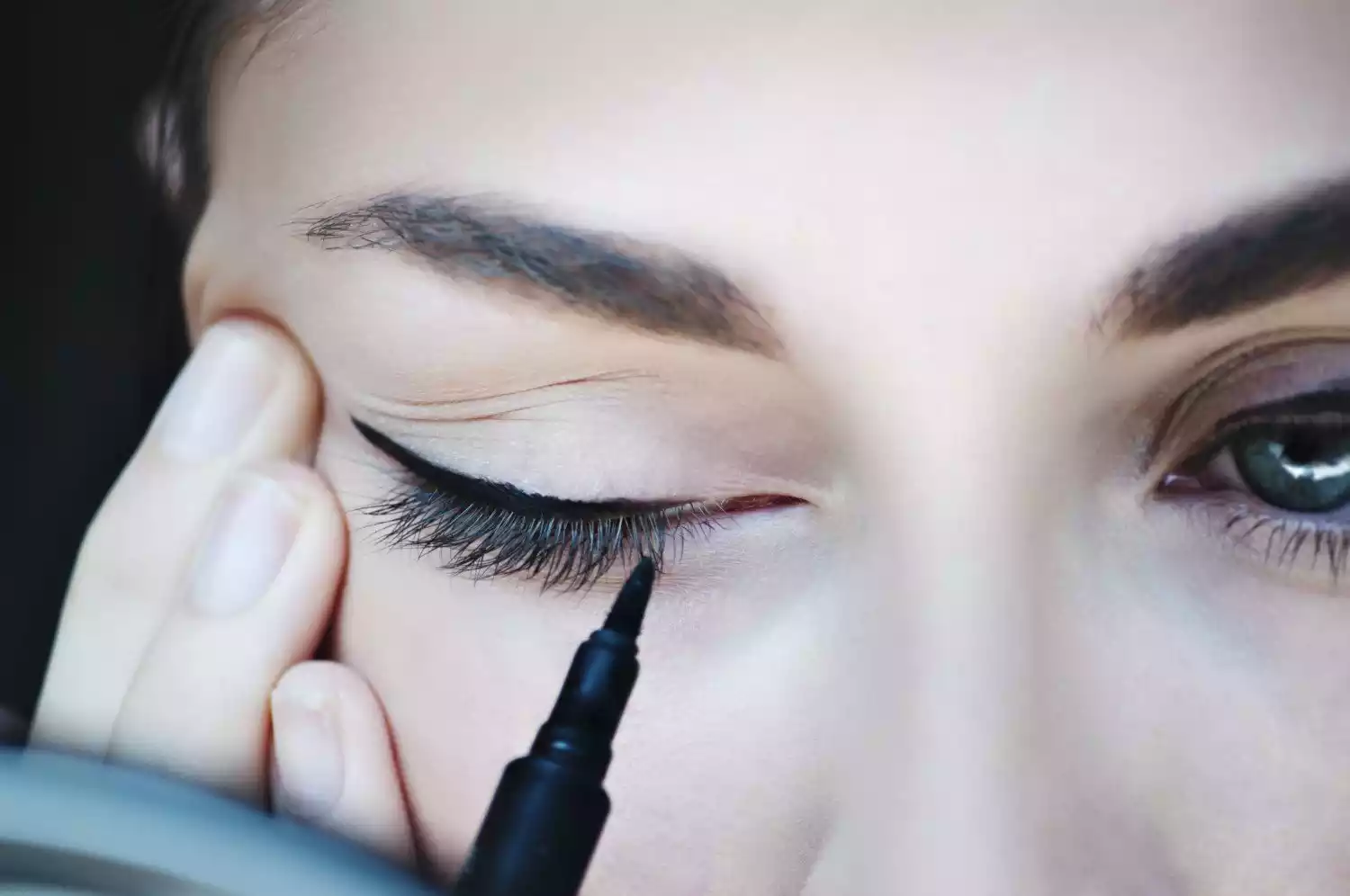
Here are some guidelines and precautions to consider:
General Safety:
- Expiration Date: All cosmetics have a shelf life. Using products past their expiration can lead to skin or eye irritations or infections due to the breakdown of ingredients or microbial contamination.
- Packaging: Always close the product tightly after use to prevent it from drying out or getting contaminated.
- Patch Test: Especially if you’re trying a new product or have sensitive skin, it’s a good idea to do a patch test first to check for any allergic reactions.
- Avoid Sharing: Never share your eyeliner or mascara with others, as this can spread infections.
- Clean Brushes: If you use brushes for applying gel eyeliner or other products, clean them regularly.
For Eyeliner:
- Avoid the Waterline: Try to avoid applying eyeliner to your waterline, especially if you wear contact lenses or have sensitive eyes. The product can block oil glands or get trapped under lenses.
- Steady Hand: Ensure you have a steady hand when applying, especially with liquid types, to prevent poking or injuring your eye.
- Natural Ingredients: If you have sensitive skin, opt for eyeliners with natural ingredients to minimize potential irritants.
For Mascara:
- Proper Removal: Always remove mascara before going to bed to prevent it from flaking and getting into your eyes, which can lead to irritation or infection.
- Gentle Application: Avoid pumping the wand in and out of the tube, as this can introduce air and bacteria into the product. Instead, swirl the wand to get the desired amount of product.
- Avoid Flaking: If your mascara tends to flake, switch products. Flakes can get into your eyes and irritate them.
- Waterproof Mascara: Use waterproof mascaras sparingly, as they can be drying to lashes and challenging to remove.
In Case of Eye Procedures or Conditions:
- Eye Surgeries: If you’ve had an eye surgery, consult with your ophthalmologist about when it’s safe to resume using eye makeup.
- Eye Infections: If you have an eye infection like conjunctivitis (pink eye), avoid using any eye makeup until the infection has fully cleared. It’s also a good idea to replace any eye makeup you were using when the infection started.
- Contact Lens Wearers: If you wear contact lenses, always apply makeup after you’ve put in your contacts. Opt for hypoallergenic and oil-free products to minimize the risk of irritation and lens contamination.
- Eye Injuries: If you’ve recently had an eye injury, refrain from using eye makeup until fully healed.
By adhering to these safety measures and precautions, you can enjoy the benefits of eyeliner and mascara while minimizing potential risks. Always prioritize your eye health and hygiene. If you ever experience persistent irritation or any adverse reactions, it’s essential to stop using the product and consult with a healthcare professional.
Conclusion
Eyeliner and Mascara, staple cosmetics in many beauty routines, serve to accentuate and define the eyes, enhancing their allure. While they both cater to the eyes, they offer distinct functionalities: eyeliners contour the lids and shape the eyes, while mascaras emphasize and volumize the lashes. Over the years, a plethora of variations and formulations have been developed, catering to diverse preferences and styles.
With their use comes the responsibility of adhering to safety precautions to maintain eye health. By understanding their differences, advantages, and potential risks, one can make informed choices and utilize these products to their full potential, ensuring that the eyes remain both captivating and healthy.

